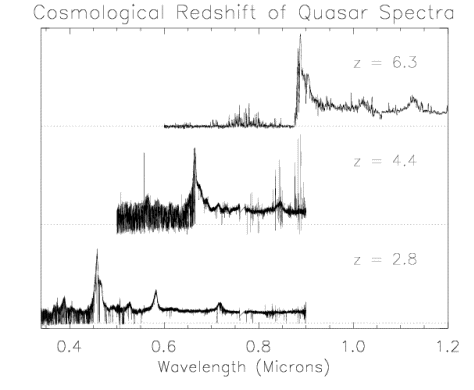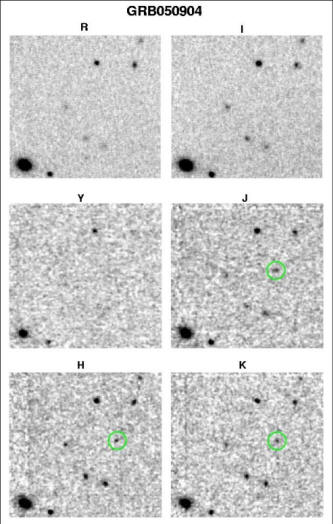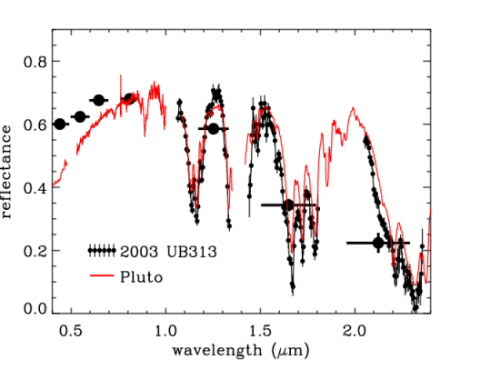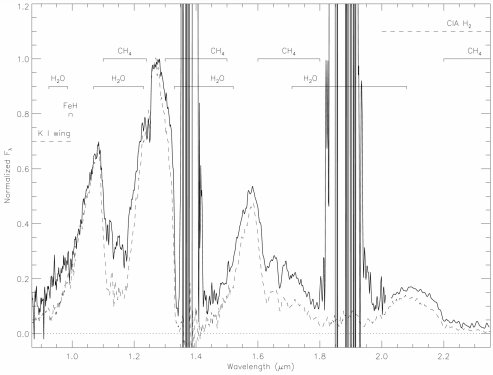FIRE
A Folded-port InfraRed Echellette for the Magellan Telescopes
Spectra of three high-redshift quasars, illustrating that for redshifts above z ~ 6, the observed energy distribution is shifted to l > 0.9 microns (R. Simcoe)

At redshifts above z ~ 6, intergalactic hydrogen absorbs the light from distant objects almost completely in the observed optical band (below l = 0.9 microns). Near-infrared spectroscopy opens access to the rest-frame ultraviolet spectral energy distributions of objects that would be studied with optical spectrographs at z ~ 2 to z ~ 4. This is illustrated in the figure at left, which shows spectra of three high redshift quasars. For the object at top, almost all of the information content in the spectrum is at wavelengths above 0.9 microns, where FIRE can be used to study heavy element pollution in quasars, galaxies, and the intergalactic medium.
FIRE will also employ a low-resolution mode with R~1200. This mode will be appropriate for observing normal galaxies and other faint sources at high redshift.
Optical (R,I) and near-IR (Y,J,H,K) images of GRB050904, a burst whose redshift was estimated at 6.28 from its lack of optical flux. (L. Cowie)

Gamma Ray Bursts
Gamma-ray bursts (GRBs) are believed to originate in the catastrophic death of massive stars and are among the most energetic events observed in the universe at all epochs. Most GRBs are accompanied by optical afterglows that can initially be several magnitudes brighter than the brightest quasars known. As many as 20% of all GRBs are estimated to occur at z > 5; GRB 050904 has recently been identified at z = 6.3.
Given their association with massive star formation, GRB afterglows may be a better probe than quasars for studying nascent galaxies at very high redshift. However, heavily obscured GRBs or events occurring at z > 6 have most of their optical light extinguished by local dust or neutral gas in the IGM. Several of these optically dark GRBs have been localized, but never followed up with IR spectroscopy. A high-throughput, high-sensitivity IR spectrometer is essential for studying the host environment that powers the GRB event at high redshift.
| Spectra of sunlight reflected from the surface of Pluto (red) and 2003UB13, the so-called "10th planet" beyond Pluto's orbit. Both show signatures of methane absorption in the near-IR. (M. Brown) |

Infrared spectroscopy is an important tool for exploring the atmospheres and surface compositions of planets in our own Solar System. In much the same way as with brown dwarf studies, IR spectra can be used to measure absorption from methane and water in the atmospheres of the gas giant planets.
Reflected sunlight spectra provide information about the makeup of the outer, cold, icy planets. It also can be used to study the surfaces of icy satellites in the Kuiper Belt, planetary moons, and the debris tails of comets.
Near-infrared spectroscopy, covering the l=0.9-2.5 micron band, is a fundamental measurement technique in ground-based astronomy. It is used to identify the most distant objects in the universe, penetrate dust obscuration in the Milky Way, study the chemical composition of planetary atmospheres, and much more.
FIRE is designed as an all-purpose facility instrument, to take advantage of Magellan's excellent image quality to advance new research in all these fields. With a higher spectral resolution than comparable existing instruments, FIRE will have particular impact in several important research areas. This list presents a small sampling of the science that will immediately be available with the commissioning of a high-resolution, high-throughput infrared spectrometer on the Magellan telescopes.
Brown dwarfs are objects that form like stars but have insufficient mass to fuse hydrogen in their cores. As such, they cool substantially over time, achieving planet-like atmospheres and physical dimensions.
Brown dwarf spectra exhibit complex molecular and atomic absorption features, requiring spectral resolutions of several thousands for abundance and kinematic analyses. These objects are also intrinsically faint, and emit the majority of their luminous flux in the IR. Such properties are ideally suited for FIRE.
Infrared spectrum of a bright brown dwarf, illustrating an abundance atmospheric features from steam and methane. (A. Burgasser)
